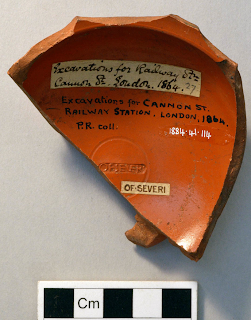Image: A Romano-British ceramic vessel from the site of Broad Street Station (now Broadgate, EC2 - behind Liverpool Street Station) collected on 17 July 1868, probably by General Pitt-Rivers himself; from the founding collection of the Pitt Rivers Museum (Pitt Rivers Museum accession number 1884.37.27)
The Excavating Pitt-Rivers team has now completed documenting the c. 1,016 archaeological objects collected by General Pitt-Rivers from London - a collection that represents just under one tenth of the c. 10,763 archaeological objects acquired by the General from England between 1851 and 1880.
Our draft report on the material from London, and the sites from which they were collected, is now published, and is online here. Through our documentation of the artefacts, we have identified a range of sites from which material was collected, largely through early instances of salvage archaeology, undertaken during groundworks for railways (including the London underground) and warehouses during the 1860s.
Image: Ceramic bowl recorded as 'found in London', collected by General Pitt-Rivers before 1881; from the founding collection of the Pitt Rivers Museum (Pitt Rivers Museum accession number 1884.37.27)
Most of the material from the City of London comes from the site of the Gooch and Cousens Warehouse on London Wall, which Pitt-Rivers published in 1867. However, further objects come from (in order of the number of objects) sites at Queenhithe Dock/Thames Street (SE1), Cannon Street & Cannon Street Station (EC4), Lothbury/Tokenhouse Yard (EC2), Bishopsgate (EC2), Broadgate (EC2), Lombard Street (EC3), Poultry/Mansion House Street (EC2), Old Jewry (EC2), Moorfields (EC2), Bucklersbury (EC4), Clement’s Lane (EC4), Mansion House (EC4), Walbrook (EC4), Billingsgate (E14), Birchin Lane (EC3), Lower Thames Street (Brewer’s Quay) (EC3), Minories (EC3), Finsbury Circus (EC2), Bell Yard/Fleet Street (EC4), Holborn Viaduct (EC1), Smithfield (EC1), Bartholomew Lane (EC2), and Cripplegate (EC2).
Beyond the City of London, there is a large collection of Palaeolithic material from Pitt-Rivers' pioneering survey of the Thames Valley near Ealing undertaken in 1869-1871. Alongside this material are objects collected or excavated from sites as diverse as Southwark Street and Borough High Street, Walthamstow; Hampton Court; Lincoln’s Inn, Serle Street; Queen Square, Camden; Yeading Brook, Hounslow Heath; Charing Cross Station; Wormwood Scrubs; Mill Hill, Barnet; Grays Inn Road; Sanderstead - and even from a cesspool at Homerton.
Many of the objects have specific dates from the 1860s, when they were collected, recorded. We hope that publishing this draft report will help us contact museum professionals, archaeologists, historians and others with knowledge of the context of the archaeology of these sites, and the history of construction at them, to add to our knowledge of Pitt-Rivers activities in early 'rescue' archaeology, from Roman, Palaeolithic and other sites in London. To contact the project, please read the report, and email dan.hicks@prm.ox.ac.uk
Image: a sherd from a Romano-British Samian ware bowl, marked as collected during excavations for the new railway station at Cannon Street in 1864; from the Pitt Rivers Museum founding collection. The potter's mark - 'OF.SEVERI' - has copied onto a label stuck to the sherd (Pitt Rivers Museum accession number 1884.41.114)
Image: Ceramic jug from Bishopsgate acquired by General Pitt-Rivers on 22 February 1878; from the founding collection of the Pitt Rivers Museum (Pitt Rivers Museum accession number 1884.37.39)
Image: a sherd of Romano-British Samian ware pottery, marked as collected from New Southwark Street on 10 December 1886 by General Pitt-Rivers (then known as 'A.L. Fox') (Pitt Rivers Museum accession number 1884.41.106)
Image: a sherd of Romano-British Samian ware pottery, collected during excavations at the Gooch and Cousens warehouse on London Wall, and evocatively marked in Pitt-Rivers' own hand as found at a depth of 13 feet 'in roadway, Dec 28 [1866], by me' (Pitt Rivers Museum accession number 1884.41.109)
Image: A Palaeolithic implement, collected from Clapham Rise, Battersea by General Pitt-Rivers on 25 September 1869. (Pitt Rivers Museum accession number 1884.122.356)
Image: Base of a sherd of Romano-British pottery, collected during excavations at the Gooch and Cousens warehouse on London Wall, and evocatively marked in Pitt-Rivers' own hand as found at a depth of 13-14 feet 'in peaty earth in roadway, Dec 28 [1866], by me' (Pitt Rivers Museum accession number 1884.41.42)










